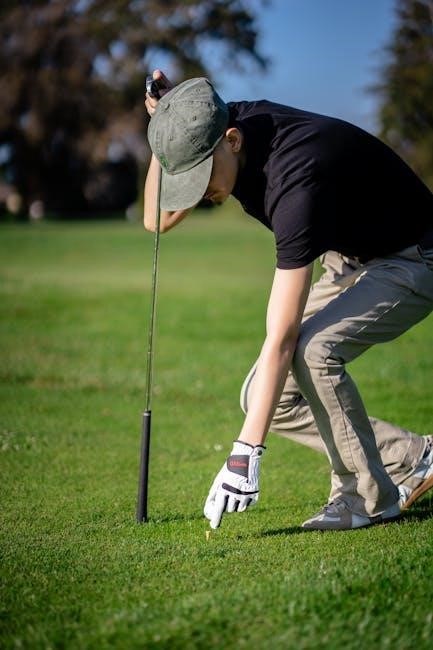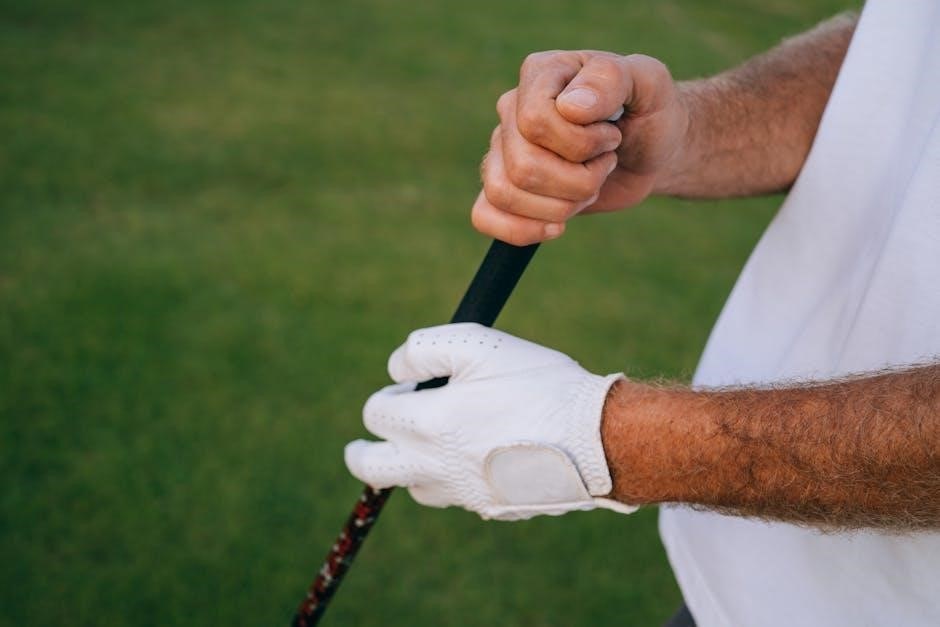
golf glove fitting guide
A properly fitted golf glove is essential for optimal performance, providing control and consistency․ This guide helps you navigate sizing, materials, and personal comfort seamlessly․
Why a Proper Fit is Essential
A proper fit ensures consistent grip pressure and control, reducing hand movement during the swing․ A snug glove prevents twisting or slipping, maintaining precise ball contact․ Loose gloves can cause blisters and discomfort, while tight ones restrict movement․ The right fit enhances feel and accuracy, crucial for consistent performance․ A well-fitting glove also promotes confidence, allowing you to focus on your game․ Neglecting fit can lead to poor swings and discomfort, making it a critical factor in your golfing success․ Proper fit directly impacts your ability to play your best game consistently․
Overview of Golf Glove Sizing
Golf gloves come in various sizes to accommodate different hand shapes and preferences․ Standard sizes range from Small to XX-Large for both men and women, while Cadet sizes cater to those with shorter fingers․ Proper sizing ensures a snug fit without restricting movement․ Sizing can vary slightly between brands, so trying gloves on is recommended․ Materials also play a role, as some gloves may stretch or conform differently․ A well-sized glove enhances grip, control, and comfort, making it a vital component of your golfing equipment․ Understanding your size ensures optimal performance and confidence on the course․

How to Measure Your Hand for a Golf Glove
Measure your hand by wrapping a tape measure around the widest part of your knuckles and noting the length of your longest finger for sizing accuracy․
Measuring Hand Circumference
To measure your hand circumference, wrap a tape measure around the widest part of your hand, just above the knuckles․ Ensure the tape is snug but not tight․ Note the measurement in inches or centimeters․ This step is crucial for determining your golf glove size․ For accuracy, keep your fingers together and your hand flat during the measurement․ If unsure, use a mirror or ask for assistance․ Proper sizing ensures a comfortable and performance-enhancing fit, allowing for better grip and control during your swing․ Accurate measurement is key to selecting the right glove for your game․
Measuring Finger Length
To measure finger length, place your hand flat with fingers extended․ Use a flexible tape measure or ruler to measure from the tip of your longest finger to the first crease below your palm․ This ensures the glove fingers fit comfortably without excess material․ For accuracy, keep your hand relaxed and fingers straight․ Measure your dominant hand, as it typically wears the glove․ This step helps ensure the glove’s fingers align perfectly with yours, providing a snug fit for better grip and control during your swing․ Proper finger length measurement is vital for optimal performance and comfort․
Understanding Hand Shape and Size
Hand shape and size play a crucial role in selecting the right golf glove․ Players with shorter fingers may prefer cadet sizes, while those with longer fingers benefit from standard sizes․ Measure your hand circumference and compare it to sizing charts to ensure accuracy․ Hands with a wider palm or thicker fingers may require a larger size for comfort․ Understanding your hand shape helps avoid loose or tight spots, ensuring a glove that enhances grip, control, and performance․ Proper fit is key to maintaining consistency and confidence in your swing․

Understanding Golf Glove Sizes
Golf glove sizes typically range from Small to Extra-Large, designed to accommodate various hand shapes and sizes․ A proper fit ensures optimal grip and control․
Standard Golf Glove Sizes
Standard golf glove sizes typically range from Small to Extra-Large, catering to most hand sizes․ These sizes are determined by measuring hand circumference and finger length․ Proper fit ensures optimal grip, control, and comfort․ A snug yet comfortable glove allows for precise ball control and consistent swings․ Ill-fitting gloves can lead to performance issues, such as slipping or restricted movement․ Refer to a sizing chart to match your measurements with the appropriate size․ Ensure the glove fits like a second skin, with no loose material, to maximize your game performance and overall satisfaction․
Cadet Sizes for Unique Hand Shapes
Cadet golf glove sizes are designed for individuals with shorter fingers but a wider palm․ These gloves offer a more tailored fit, ensuring comfort and control for players with unique hand shapes․ The cadet size provides a snug fit across the fingers while accommodating a broader palm, preventing restrictive movement․ This option is ideal for those who find standard sizes too tight or too loose․ Cadet gloves promote better grip and stability, enhancing overall performance on the course․ They are a specialized solution for golfers seeking a precise, comfortable fit tailored to their hand structure․
Men’s vs․ Women’s Sizing Differences
Men’s and women’s golf gloves differ in sizing to accommodate anatomical differences․ Men’s gloves are generally larger, with deeper fingers and a broader palm, while women’s gloves are smaller, offering a more tailored fit for narrower hands․ Women’s gloves often feature more flexible materials for better dexterity․ Sizing charts vary between genders, so it’s crucial to use the correct guide․ Proper fit ensures optimal performance, regardless of gender․ Both styles prioritize comfort and control, but the design caters to average hand shapes and preferences for men and women․ Choosing the right size ensures a snug, functional fit for any golfer․

Key Features of a Well-Fitting Golf Glove
A well-fitting golf glove offers a snug yet comfortable fit, with high-quality materials, breathability, and grip enhancement․ It provides flexibility, support, and durability for optimal performance․
Material and Comfort
Material and comfort are crucial for a golf glove’s performance․ Premium leather offers durability and a natural feel, while synthetic materials provide breathability and flexibility․ Look for moisture-wicking fabrics to keep hands dry and comfortable during play․ Proper padding in key areas, such as the palm and fingers, enhances grip and reduces fatigue․ A well-designed glove should minimize bulk, allowing for a full range of motion․ The right material ensures a snug fit without sacrificing comfort, enabling better control and consistency in your swing․
Flexibility and Mobility
A golf glove must strike a balance between support and flexibility to allow natural hand movement․ Look for features like four-way stretch panels, which enhance mobility without compromising grip․ Seamless construction ensures flexibility across the knuckles, preventing restriction during the swing․ Thin, breathable materials maintain dexterity, while reinforced palms provide stability․ Proper flexibility ensures you can grip the club firmly yet maintain precise control throughout your swing․ A glove that moves naturally with your hand maximizes performance and comfort, allowing you to focus on your game without distractions․
Support and Grip
A well-fitting golf glove provides essential support and grip, ensuring consistent control throughout your swing․ The palm should fit snugly, with no loose material, while the fingers should feel secure without restriction․ High-quality materials, such as leather or advanced synthetic fabrics, offer durability and traction, even in wet conditions․ Proper grip support prevents the club from slipping, allowing for precise shots․ A glove with reinforced padding in key areas enhances stability without compromising feel, ensuring a confident connection to the club and improved performance on the course․

How to Try On a Golf Glove
When trying on a golf glove, insert your fingers snugly, ensuring no loose material․ The fit should feel like a second skin, with the palm hugging tightly and fingers aligning naturally․ Adjust the closure for comfort and security, ensuring optimal grip without restriction․ Proper fit ensures consistent performance and control during your swing․
Step-by-Step Fitting Process
Start by gently inserting your four long fingers into the glove, ensuring each finger fits snugly into its compartment․ Next, place your thumb into the thumb section, adjusting for comfort․ Secure the closure system, such as Velcro, to achieve a snug but not overly tight fit․ Check that the palm material hugs your hand tightly without excess fabric․ Ensure the fingers are aligned properly and the glove allows for natural wrist and finger movement․ Finally, verify that the fit feels like a second skin, providing both support and flexibility for your swing․
Adjusting the Glove for Optimal Fit
Once the glove is on, ensure it fits snugly without feeling restrictive․ Adjust the closure system, such as Velcro straps, to secure the fit around your wrist․ Gently pull the cuff to align the palm material with your hand, ensuring no bunching or wrinkles․ Smooth out the fingers to prevent creases and ensure proper alignment․ Check that the glove allows for natural hand and wrist movement while maintaining a snug fit․ Fine-tune the fit by tugging lightly on the fingers and cuff to eliminate any loose areas․ Proper adjustments ensure maximum comfort, grip, and performance during your swing․

Common Mistakes in Golf Glove Fitting
Choosing the wrong size, ignoring material quality, and not considering hand shape are common errors․ These mistakes can lead to discomfort and poor performance during play․
Choosing the Wrong Size
Choosing the wrong size is a frequent mistake that can hinder performance․ A glove that is too tight restricts movement and causes discomfort, while one that is too loose leads to lack of control․ Proper sizing ensures a snug fit across the palm and fingers, allowing for precise grip and mobility․ Measure hand circumference and finger length accurately to avoid this error․ Trying on gloves and considering personal comfort is crucial, as ill-fitting gloves can lead to blisters and affect your swing consistency․ Always refer to a sizing chart for the best fit․
Overlooking Material Quality
Overlooking material quality is a common mistake that can affect comfort and performance․ High-quality materials, such as breathable leather or moisture-wicking synthetic fabrics, ensure durability and grip․ Cheap materials may lead to discomfort, poor fit, or a lack of control․ Prioritizing material quality ensures the glove lasts longer and performs consistently․ Look for materials that balance flexibility, support, and moisture management․ A well-made glove enhances your swing and overall experience, making it essential to invest in premium quality for optimal results on the course․
Not Considering Hand Shape
Not considering hand shape is a frequent error that can lead to discomfort and poor performance․ Hands vary in shape, with some having broader palms or shorter fingers․ Standard sizes may not cater to unique hand shapes, causing an ill fit․ Cadet sizes are designed for hands with shorter fingers but a larger palm circumference․ Ignoring hand shape can result in a glove that restricts movement or lacks support․ Ensure your glove matches your hand’s specific contours for optimal comfort and grip․ Proper fit enhances control and consistency, making hand shape a critical factor in glove selection․

Golf Glove Fit and Performance
A well-fitting glove enhances swing consistency and control, ensuring a secure grip and improved accuracy․ Proper fit directly impacts performance, making it vital for optimal gameplay․
How Fit Impacts Swing and Control
A properly fitted golf glove ensures consistent grip pressure, preventing slips during the swing․ A snug fit enhances finger mobility, allowing precise control over the club․ Loose gloves can cause inconsistent ball striking, while tight gloves restrict movement․ The right fit minimizes hand fatigue, maintaining accuracy and stability throughout the round․ Proper fit directly influences swing mechanics, enabling better shot execution and overall performance․ A glove that fits like a second skin is crucial for maximizing control and achieving consistent results on the course․
Importance of a Snug but Comfortable Fit
A snug yet comfortable fit ensures stability without restricting movement․ It prevents hand fatigue and blisters, allowing consistent grip pressure․ A glove that’s too tight can hinder flexibility, while one that’s too loose may slip during the swing․ Proper fit balances support and freedom, enabling precise control and consistent performance․ High-quality materials that mold to your hand provide durability and comfort, ensuring the glove feels natural throughout the round․ This balance is key to maintaining focus and delivering your best game․

Golf Glove Sizing Chart
Use our golf glove sizing chart to find your perfect fit based on hand circumference and finger length for optimal performance․
Standard Size Chart
The standard size chart for golf gloves is based on hand circumference and finger length measurements․ To determine your size, measure the circumference of your hand around the palm at the widest point․ Next, measure the length of your middle finger from the base to the tip․ Compare these measurements to the chart, which typically ranges from Small to Extra-Large sizes․ A proper fit should feel snug but not restrictive, allowing for full finger mobility and control․ Use the chart to match your measurements for the best fit and optimal performance․
Cadet Size Chart
Cadet size charts cater to golfers with shorter fingers but a larger palm circumference․ These sizes provide a better fit for unique hand shapes, ensuring comfort and control․ To use the cadet chart, measure your hand circumference and compare it to the cadet-specific measurements, which often include options like Cadet Small, Medium, and Large․ This sizing system ensures the glove isn’t too tight or bulky, allowing for precise grip and mobility․ Cadet sizes are ideal for players who find standard gloves restrictive or ill-fitting due to their hand proportions, offering a tailored fit for optimal performance․
Caring for Your Golf Glove
Regularly clean your glove with mild soap and cold water․ Allow it to air-dry, reshaping it while damp․ Store in a cool, dry place to maintain quality and fit․
Cleaning and Maintenance Tips
To keep your golf glove in prime condition, wash it by hand using mild soap and cold water․ Gently scrub the palm and fingers, then rinse thoroughly․ Avoid machine washing, as it can damage the material․ Allow the glove to air-dry, reshaping it while still damp to maintain its fit․ Store the glove in a cool, dry place, away from direct sunlight․ For tougher stains, mix a small amount of vinegar with water and apply gently․ Never use harsh chemicals or bleach, as they can weaken the leather or synthetic materials․ Regular cleaning and proper storage will extend the life of your glove and ensure consistent performance on the course․
Storing the Glove Properly
Store your golf glove in a cool, dry place away from direct sunlight to prevent fading and material degradation․ Lay it flat or use a glove tree to maintain its shape․ Cover it with a breathable cloth to protect from dust․ Avoid folding, as this can cause creases and misshape the glove․ Ensure the glove is clean and dry before storing to prevent mold and odors․ Regularly inspect for signs of wear, and replace it if necessary․ Proper storage extends the glove’s lifespan and ensures it remains comfortable and functional for your next round of golf․

Choosing the Right Glove for Weather Conditions
Gloves for Hot Weather
Choose gloves with moisture-wicking materials and breathable mesh to keep hands dry․ Opt for lightweight designs with snug fits to enhance grip and comfort in warm conditions․
For hot weather, opt for gloves made from breathable, moisture-wicking materials like mesh panels to keep hands cool and dry․ Lightweight designs with perforations enhance airflow, reducing sweat buildup․ A snug fit ensures a firm grip without restricting finger movement․ Look for gloves with UV protection to prevent sun damage․ Proper ventilation and soft, flexible leather improve comfort during warm rounds․ These features combine to maintain dexterity and control, even in high temperatures, ensuring your game remains unaffected by the heat․
Gloves for Cold Weather
For cold weather, choose gloves with thermal insulation and waterproof materials to keep hands warm and dry․ Look for features like fleece-lined palms or textured grips to maintain control in chilly conditions․ Breathable fabrics prevent moisture buildup, while elastic cuffs ensure a snug fit․ Some gloves offer touchscreen compatibility for convenience․ Opt for materials that balance warmth with flexibility, ensuring you can still feel the club․ Proper fit is crucial to avoid restricting movement․ Cold-weather gloves should provide durability, grip, and comfort, allowing you to play confidently in cooler temperatures without compromising your game․
Specialized Golf Gloves
Specialized gloves cater to unique needs, offering cadet sizes for different hand shapes and all-weather options for play in various conditions, ensuring optimal performance and comfort․
Cadet Gloves for Unique Hand Shapes
Cadet gloves are designed for golfers with shorter fingers or broader palms, offering a tailored fit․ They feature shorter finger lengths and a wider palm area, reducing excess material for enhanced control․ These gloves are ideal for players with unique hand shapes, providing comfort and precision․ Cadet sizes are available in both men’s and women’s options, ensuring a snug fit without compromising grip or flexibility․ By addressing specific hand types, cadet gloves help improve performance and confidence on the course, making them a popular choice for those seeking a more personalized fit․
All-Weather Gloves
All-weather golf gloves are designed to perform in various conditions, from hot summer days to cool, damp mornings․ They combine breathable, moisture-wicking materials with water-resistant technology to keep hands dry and comfortable․ These gloves provide consistent grip and control, even in wet or sweaty conditions, while maintaining flexibility for a natural swing․ Ideal for golfers who play year-round, all-weather gloves are versatile and durable, ensuring peak performance regardless of the weather․ Their advanced materials and ergonomic design make them a practical choice for players seeking reliability across diverse environments․
Frequently Asked Questions
Common questions include whether a glove is necessary, how often to replace it, and tips for maintaining fit and comfort․ Explore these answers here․
Do I Need a Golf Glove?
A golf glove is not mandatory but highly recommended․ It enhances grip, reduces hand fatigue, and improves control, especially in moist conditions․ While some players prefer going bare-handed, a glove is crucial for consistent performance․ Proper fit ensures comfort and effectiveness․ Whether you choose to wear one depends on personal preference and playing conditions, but most golfers find it beneficial for a better swing and score․
How Often Should I Replace My Glove?
The frequency of replacing a golf glove depends on usage and condition․ For frequent players, such as those who play twice a week, the glove may need to be replaced every few months․ Signs indicating the need for replacement include wear on the palm, fraying, and decreased grip․ The material also plays a role, with leather gloves being durable but still susceptible to wear․ Proper maintenance, like regular cleaning and storage, can extend the glove’s life․ It’s advisable to consult official guidelines or seek advice from a pro shop for precise recommendations․
A well-fitting golf glove enhances performance and comfort․ Prioritize proper fit, material quality, and maintenance to maximize your game and extend glove life․
Final Tips for the Perfect Fit
Ensure a snug, second-skin fit without restricting movement․ Measure both hand circumference and finger length for accuracy․ Try gloves on your dominant hand and refer to size charts․ Prioritize breathable, durable materials for comfort and grip․ Avoid overly tight gloves, as they may hinder flexibility․ Consider cadet sizes if you have shorter fingers or wider palms․ Proper fit enhances control, consistency, and overall performance, making it a vital part of your golf setup․
Importance of Proper Fit in Your Game
A well-fitting golf glove is crucial for consistency and control, acting as a second skin to enhance your swing mechanics․ It prevents slipping and provides a secure grip, even in wet conditions․ Proper fit reduces hand fatigue and ensures precise ball handling․ A glove that’s too tight or too loose can disrupt your game, affecting accuracy and confidence․ Prioritizing fit ensures optimal performance, allowing you to focus on your technique and enjoy a more satisfying playing experience․ A perfect fit is an essential tool for improving your overall golf game․